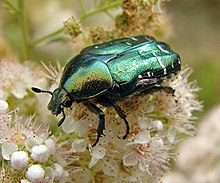Polyphaga
| Polyphaga Temporal range:
| |
|---|---|

| |
| Cetonia aurata | |
| Scientific classification | |
| Domain: | Eukaryota |
| Kingdom: | Animalia |
| Phylum: | Arthropoda |
| Class: | Insecta |
| Order: | Coleoptera |
| Suborder: | Polyphaga Emery, 1886 |
| Infraorders | |
|
Bostrichiformia Scarabaeiformia Staphyliniformia | |
Polyphaga is the largest and most diverse
Key characteristics of Polyphaga are that the hind
Etymology
The name of polyphaga is derived from two Greek words: poly-, meaning 'many', and phagein, meaning 'to eat', so the suborder is called the “eaters of many things”.
Classification
The five main infraorders are:
- skin beetles
- checkered beetles and leaf beetles
- Elateriformia — includes click beetles and fireflies
- dung beetles
- Staphyliniformia — includes rove beetles and water scavenger beetles
Phylogenetic studies have also suggested that Scirtoidea (
The internal classification of Polyphaga involves several superfamilies or series, whose constituents are relatively stable, although some smaller families (whose rank even is disputed) are allocated to different clades by different authors. Large superfamilies include Hydrophiloidea, Staphylinoidea, Scarabaeoidea, Buprestoidea, Byrrhoidea, Elateroidea, and Bostrichoidea.
The infraorder
See also
References
- ISBN 0-03-096835-6.
- PMID 35345430.
- Cranston, Peter S.; Gullan, Penny J. (2009). "Phylogeny of Insects". In Resh, Vincent H.; Cardé, Ring T. (eds.). Encyclopedia of Insects (Second ed.). Academic Press. pp. 780–793. ISBN 978-0-12-374144-8.
